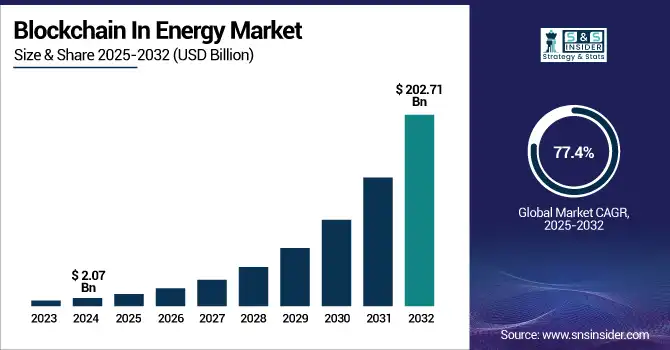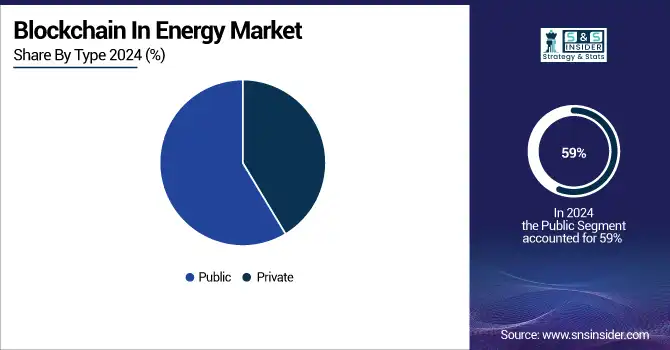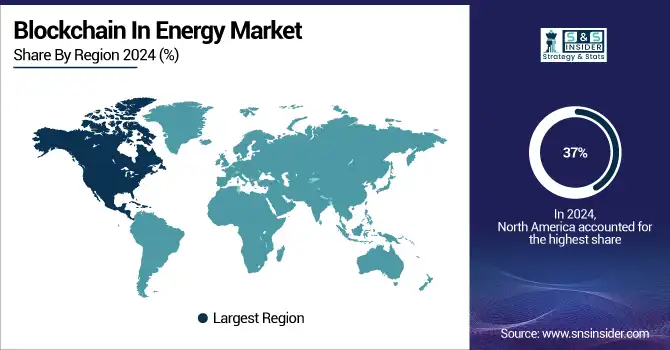Blockchain In Energy Market Report Scope & Overview:
The Blockchain in Energy Market size was valued at USD 2.07 billion in 2024 and is expected to reach USD 202.71 billion by 2032 and grow at a CAGR of 77.4% over the forecast period 2025-2032.

To Get more information on Blockchain in Energy Market - Request Free Sample Report
The Market Trends is disrupting the traditional energy systems and the ways we produce, trade, and consume energy with its principles of transparency, decentralization, and near-real-time data verification. This technology allows peer-to-peer energy trading, efficient grid management, secure transactions, lower cost, and increased reliability in the system. Infrastructure giants such as IBM, Microsoft, and start-ups such as LO3 Energy are leading innovations and are working with utilities and governments to scale pilot projects around the world.
In 2024, LO3 Energy initiated a pilot project for a blockchain-based microgrid in Brooklyn that allowed residents to sell excess solar power to each other. This decentralized energy economy model utilizes the power of real-time data and smart contracts to make digital, green energy more transparent and the grid more efficient while sparking consumer participation in sustainable energy systems.
The U.S. Blockchain in Energy Market size was USD 0.52 billion in 2024 and is expected to reach USD 44 billion by 2032, growing at a CAGR of 74.15% over the forecast period of 2025–2032.
The U.S. dominates the Blockchain in Energy Market due to its advanced digital infrastructure, strong presence of tech giants, and significant investments in renewable energy and smart grid technologies. Collaborations between energy firms and blockchain innovators, Such as Microsoft and IBM, drive rapid adoption. Government support for energy decentralization and carbon tracking also boosts market growth, positioning the U.S. as a global leader in energy blockchain applications and innovation.
Blockchain In Energy Market Dynamics
Key Drivers:
-
Increasing Demand for Decentralized and Transparent Energy Systems Accelerates the Growth of Blockchain in the Energy Market
The Blockchain In Energy Market Growth is increasing focus on cost saving and reaching decentralized energy products, and transparency in energy transactions are also some of the factors that are leading the market. As consumers and businesses increasingly flock towards renewable energy blockchain and smart grids, Blockchain provides a way to improve trust and efficiency in energy trading. It is above all due to the request for a secure, automated, and real-time transaction, especially for peer-to-peer energy markets.
Moreover, blockchain allows for safe tracking of renewable energy credits that promote transparency in carbon and emissions credits. With increasing emphasis on sustainability goals by governments and companies, blockchain can be essential to enabling secure, transparent transactions in the future of energy.
Restraint:
-
High Implementation Costs and Complexity Limit the Widespread Adoption of Blockchain in the Energy Sector
High costs of implementation, as well as the technology complexity of blockchain solutions, are key barriers to mass adoption in the energy industry. Blockchain energy industry systems need infrastructure, robust protection, and a large outlay on technology and the training of those who use it. Most utilities and energy companies are hesitant to spend money on blockchain and are unsure what the return will be for the investment.
Opportunity:
-
Growing Focus on Renewable Energy and Sustainability Creates Opportunities for Blockchain to Revolutionize Energy Trading and Tracking
The increasing shift towards renewable energy consumption and the emphasis on sustainability provide a vast opportunity for blockchain to redesign the energy trading and tracking mechanisms. As the solution to the world’s clean-energy transition, blockchain presents the trade of renewable energy credits, carbon emissions, and distributed energy resources management in an efficient, secure, and transparent way.
For instance, companies such as WePower are already leveraging blockchain to enable the direct trading of renewable energy, allowing energy producers and consumers to exchange energy in a decentralized manner.
Challenge:
-
Regulatory Uncertainty and Lack of Standardization Hinder Blockchain’s Full Potential in the Energy Market
Lack of regulatory certainty and absence of standardized architecture for blockchain applications that concentrate on energy is one of the critical issues that the Blockchain in Energy Market analysis faces the lack of well-defined international regulatory standards for the use of blockchain in the energy market is hindering the development of the technology. For example, some regions are more receptive to applications of blockchain in energy markets, while others are still undecided about their legal status.
Blockchain In Energy Market Segments Analysis
By Type
The Public segment dominated the market, with a share of 59% in 2024, due to its open-access feature, enabling transparency and trust among different participants in decentralized energy systems. Projects such as Power Ledger in Australia and the Brooklyn Microgrid, operated by LO3 Energy, use public blockchains to enable peer-to-peer trading of energy and provide access to the grid. Another factor driving the market is that the openness of public blockchain is in tune with energy democratization.
The Private segment is expected to grow at the highest CAGR of 80.7% during the forecast period, as utilities and enterprises are focusing on data security, regulatory compliance, and high-speed transactions. IBMs and SAPs have both announced private blockchain networks that allow for data to be shared and trades to be automatically executed in the energy sector.

By End-Use
The Power segment held a major share in the Blockchain in Energy Market in 2024, due to an increase in smart grid deployments and capacity addition of renewable power generation. Notable blockchain solutions for PPAs and energy tokenisation have been developed by key players such as WePower and Electrify. They help to make settlements faster and more transparent, making blockchain consistent with global power sector modernization objectives.
The Oil & Gas segment is estimated to grow at the highest CAGR of 82.07% from 2025 to 2032, owing to the demand to increase transparency, traceability, and veracity of the supply chain. Firms such as Accenture and IBM are developing blockchain technology for tracking oil shipments and managing complex contracts.
By Application
P2P was the largest segment, holding a 33% revenue share in 2024 on account of decentralized energy models that enable energy consumers to be energy producers. Power Ledger and LO3 Energy are blockchain companies that make neighborhood energy sharing possible, which decreases reliance on central utilities. This notion of democratizing energy trade propelled the Blockchain in the Energy Market quite ahead.
The Grid Transactions segment is projected to be the fastest-growing market, at a CAGR of 82.1%, from 2025 to 2023, due to the requirement for automated and real-time settlements of energy in upgraded grids. Microsoft and Siemens bring blockchain to smart grid management and energy trading. These developments enhance grid capacity and stability, marking an evolution of the blockchain’s role in modernizing our energy systems.
Regional Analysis
North America in the Blockchain in Energy Market share in 2024, with a market share of over 37%, North America emerged as the leading consumer of blockchain in energy, attributed to decentralized energy solutions and next-generation digital infrastructure. The U.S. is ahead in the region thanks to proactive clean energy mandates, big investments from tech firms such as IBM and Microsoft, and strong pilot projects for peer-to-peer energy trading and carbon tracking systems.
The Asia Pacific region is projected to be the fastest-growing market in the Market between 2025 and 2032, with 80.8% of CAGR during the forecast period. China dominates the Blockchain in Energy Market, driven by its massive energy demand, rapid digital transformation, and strong government support for blockchain adoption. China is heavily investing in smart grid infrastructure and renewable energy, where blockchain enhances efficiency and transparency. A State Grid Corporation of China, which in 2024 partnered with tech firms to launch blockchain-based energy trading platforms, improving grid management and enabling real-time, decentralized transactions across provinces.
Europe continued to hold a high market share in the Blockchain in Energy Market in 2024, due to the EU's focus on renewable incorporation, emission reduction, and energy transparency. Germany dominates the Blockchain in the Energy Market due to its advanced renewable energy infrastructure and early adoption of digital technologies in the energy sector. Germany's strong focus on decentralization and its energy transition policy has fueled blockchain experimentation in peer-to-peer energy trading and grid optimization.
The Middle East & Africa and Latin America are showing steady growth in the Blockchain in Energy Market due prevalence of demand for energy transparency, integration of renewable energy, and infrastructure upgradation till 2024. These areas are using blockchain to optimize and secure energy transactions so that grid inefficiencies can be minimized.

Get Customized Report as per Your Business Requirement - Enquiry Now
Key players:
The major players operating in the market are BigchainDB GmbH, LO3 Energy, Inc., Deloitte Touche Tohmatsu Limited, Microsoft Corporation, IBM Corporation, WePower UAB, Accenture plc, Oracle Corporation, SAP SE, and Infosys Limited.
Recent Trends
-
In January 2024, LO3 Energy initiated a pilot microgrid project utilizing blockchain for energy distribution. This project aims to enhance local energy trading and grid efficiency, reflecting LO3 Energy's continued commitment to integrating blockchain solutions in the energy sector.
-
In May 2023, Deloitte joined a consortium of financial and technology firms to launch the Canton Network, a blockchain network designed for secure, interoperable, and privacy-preserving transactions. While primarily focused on financial markets, the network's capabilities have implications for energy trading and resource management, indicating Deloitte's strategic interest in applying blockchain across various sectors, including energy.
| Report Attributes | Details |
|---|---|
| Market Size in 2024 | USD 2.07 Billion |
| Market Size by 2032 | USD 202.71 Billion |
| CAGR | CAGR of 77.4% From 2025 to 2032 |
| Base Year | 2024 |
| Forecast Period | 2025-2032 |
| Historical Data | 2021-2023 |
| Report Scope & Coverage | Market Size, Segments Analysis, Competitive Landscape, Regional Analysis, DROC & SWOT Analysis, Forecast Outlook |
| Key Segments | • By Type (Private, Public) • By Application (Sustainability Attribution, Electric Vehicle, Energy Financing, Grid Transactions, Peer-To-Peer Transaction, Others) • By End-Use (Power, Oil & Gas) |
| Regional Analysis/Coverage | North America (US, Canada, Mexico), Europe (Germany, France, UK, Italy, Spain, Poland, Turkey, Rest of Europe), Asia Pacific (China, India, Japan, South Korea, Singapore, Australia, Rest of Asia Pacific), Middle East & Africa (UAE, Saudi Arabia, Qatar, South Africa, Rest of Middle East & Africa), Latin America (Brazil, Argentina, Rest of Latin America) |
| Company Profiles | BigchainDB GmbH, LO3 Energy, Inc., Deloitte Touche Tohmatsu Limited, Microsoft Corporation, IBM Corporation, WePower UAB, Accenture plc, Oracle Corporation, SAP SE, Infosys Limited. |

